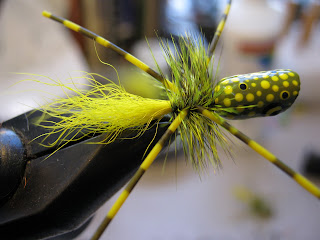First up, the finished popper body is placed in the vise
Next thread is added. I use size 8/0 for all of our poppers. After the thread comes the calf tail. This is tied in right behind the popper body and then the thread is wrapped back to the bend of the hook.
Next up is the hackle. I personally like the hackle to match the body and tail as much as possible. For this one I use dyed olive grizzly saddle hackle. The hackle is secured right at the bend of the hook. The thread is advanced right to about the midway point of the hook which is usually just over the point of the hook.
After the thread has been advanced to above the hook point, the legs are added. Again, this is really up to the tier as to what they use. We like the grizzly barred rubber legs by Hareline. I have found that other leg material such as Sili legs tends to (a) break easily and (b) weigh the fly down. The rubber legs actually help with balance and buoyancy as well. The legs are added to each side in an X. The right side is added first and then the left. Well really that's how I do it but not sure it really matters. After the legs are secured with some wraps of thread, the thread is now advanced to right behind the body of the popper. After that is done, the hackle is advanced to right behind the body of the popper where it is tied off. A few turns of the whip finisher tool and you are done.
The finished product:








Good stuff. Bass and monster bluegill getter.
ReplyDeleteThanks for sharing the techniques and tips on fly tying material. Colorado Bass and Bluegill beware!
ReplyDeleteMel,
DeleteI would love to see you tie up some poppers. You need to work on Howard a little. Get him to drink the Kool Aid and come to the dark side!